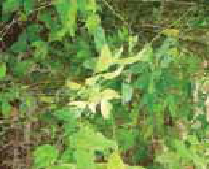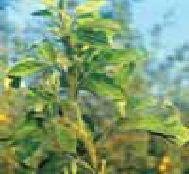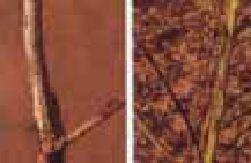Redgram: Diseases and Symptoms
Redgram: Diseases and Symptoms
Wilt
Disease symptoms- Symptoms can appear 4 to 6 weeks after sowing. The initial visible symptoms are loss of turgidity in leaves, and slight interveinal clearing.
- The foliage shows slight chlorosis and sometimes becomes bright yellow before wilting.
- Leaves are retained on wilted plants. The initial characteristic internal symptom of wilt is the browning of the xylem vessels from the root system to the stems.
- The xylem gradually develops black streaks, and brown or dark purple bands appear on the stem surface of partially wilted plants extending upwards from the base.
- When the bark of such bands is peeled off , browning or blackening of the wood beneath can be seen. in wilt-tolerant genotypes these bands are confined to the basal part of the plant.
- Sometimes, especially in the later stages of crop growth, the branches dry from the top downwards, but symptoms are not seen on the lower portions of the main stem or branches.
- Small branches on the lower part of the plant also dry.
- When the main stem of such plants is split open, intensive blackening of the xylem can be seen.
- In humid weather, a pinkish mycelial growth is commonly observed the basal portions of the wilted plants.
- Partial wilting is usually associated with lateral root infection. Tap root infection results in complete wilting.
- The fungus is soil borne and survive in the soils. Fungus spreads about 3 m through the soil in one season, apparently along roots.
- The fungus was found to survive in infected plant stubble for 2.5 years Vertisols and 3 years in Alfisols.
- Low soil temperature and increasing plant maturity favours wilt.
- Fungal population is highest at 30% soil water-holding capacity and at the soil temperatures between20 and 30° C.
Pigeon pea sterility mosaic disease
Disease symptoms Bushy and stunted appearance of the infected plants due to reduction in the size of the leaves and proliferation of the branches.
Bushy and stunted appearance of the infected plants due to reduction in the size of the leaves and proliferation of the branches.- Light and dark green mosaic pattern on the infected leaves of younger plants.
- Partial or complete sterility of the plant resulting in low or no flowering and podding.
- When infections occurs at 45 days after emergence or later only some parts of the plant may show disease symptoms, while the remaining parts appear normal.
- Leaves become small and cluster near branch tips.
- Diseased plants are pale green and bushy in appearance, without of flowers and pods.
- Diseased plants are usually in groups.
- Sometimes a plant may not show symptoms in the first flush, but when ratooned the new growth shows clear symptoms and tend to disappear as the plants mature.
- A single eryophid mite (A. cajani) (vector) is sufficient to transmit the disease.
- Perennial and volunteer pigeon pea and the ratooned growth of harvested plants provide reservoirs of the mite vector and the pathogen.
- Shade and humidity encourage multiplication of the virus.
Stem blight
Damage symptoms- This cause seedling to die suddenly.
- Water soaked, irregular lesions on the leaves often cause blighting of the leaf/leaflets and younger plant.
- Infected leaves loss turgidity and become dessicated.
- Brown sunken lesions on the stem and branches causing girdling and makes the infected stem weak and leads to breakage and drying of the plant/branches.
- Infection mostly confined to basal portion of the stem.
- The fungus is soil borne.
- The fungus survives as dormant mycelium in soil and on infected plant debris.
- Soils with poor drainage
- Low lying areas
- Heavy rain.
- Temperature 28-30o C.
Mung bean mosaic disease
Disease symptoms This disease was probably reported first from Sri Lanka.
This disease was probably reported first from Sri Lanka.- The disease first appears in the form of yellow, diff used spots scattered on the leaf lamina, not limited by veins and veinlets.
- Such spots slowly expand and in later stages of disease development, affected leaflets show broad, yellow patches alternating with green colour.
- Sometimes the entire lamina turns yellow.
- Leaf size is conspicuously reduced in early infections.
- In peninsular India, disease incidence is relatively higher in late-sown pigeon pea.
- The vector is whitefly (Bemisia tabaci)
- A single whitefly vector is sufficient to transmit the disease.
- Perennial and volunteer pigeon pea and the ratooned growth of harvested plants provide reservoirs of the vector and the pathogen.
- Shade and humidity encourage multiplication of the virus.
Dry root rot
Disease symptoms Typical symptoms include root and basal stem rot with a large number of minute, fungal sclerotia visible under the bark.
Typical symptoms include root and basal stem rot with a large number of minute, fungal sclerotia visible under the bark.- Plants dry prematurely, particularly when they face drought stress.
- Disease incidence severe in off -season, irrigated, summer crops in several parts of India, and it is a minor one in the normal-season crop. The pathogen is both soil- and seed borne.
IPM for Redgram
To know the IPM practices for Redgram, click here.
Source: NIPHM and Directorate of Plant Protection, Quarantine & Storage
Last Modified : 2/26/2020
© C–DAC.All content appearing on the vikaspedia portal is through collaborative effort of vikaspedia and its partners.We encourage you to use and share the content in a respectful and fair manner. Please leave all source links intact and adhere to applicable copyright and intellectual property guidelines and laws.
RELATED ITEMS
Redgram: Crop Stage-wise IPM
This topic covers the Information related to Crop ...
Redgram: Natural Enemies
Natural enemies of Redgram insect pests are covere...
Coriander Diseases
This topic provides information about Coriander D...
Redgram Pests
This topic covers the information related to Pest ...
